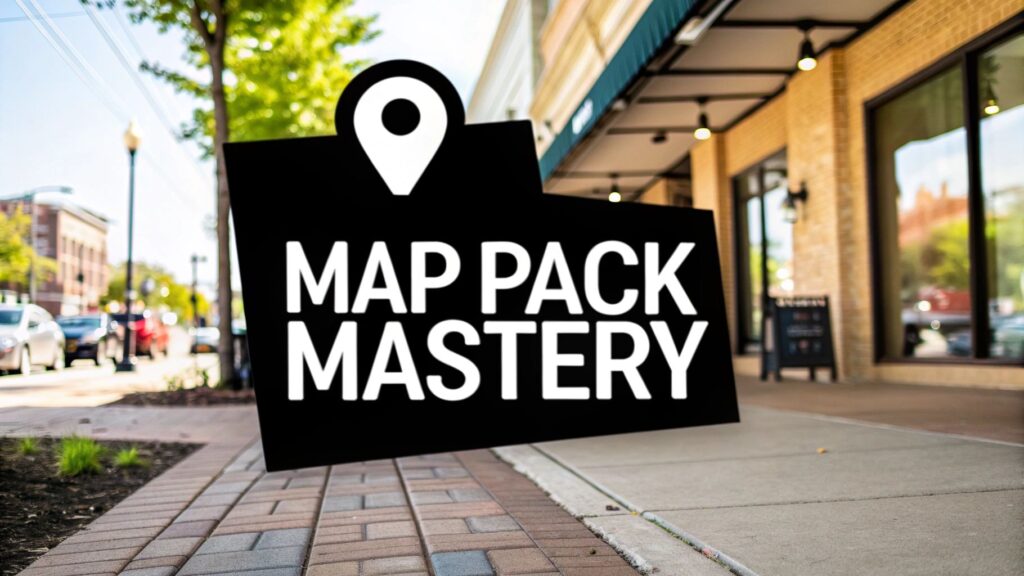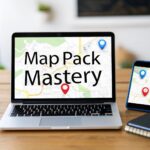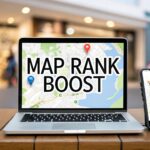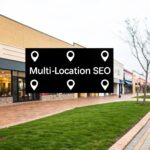A great fade and good conversation are key, but they don't fill chairs if new clients can't find you online. SEO for barbers is the modern version of word-of-mouth. It gets your shop in front of everyone in your neighborhood searching "barber near me" on their phone.
This is the difference between an empty chair and a schedule booked for weeks.
Why SEO Is a Barber's Best Tool
Think about it: when was the last time someone used the Yellow Pages? Today, your next client is searching on Google. If you don't show up on the first page, you're practically invisible. The entire game is online now.
This isn't about learning complex code. It's about being visible where it matters.
Imagine two barbershops. The first has a talented barber who just waits for walk-ins. The second barber, just as skilled, uses simple online tools to appear at the top of local searches. While the first barber hopes the door opens, the second gets notifications for new online bookings. That’s what good SEO does.
The Basics of Barbershop SEO
To understand this, let's break down what works for a local business like a barbershop. These aren't just tasks; they're the foundation for a steady stream of clients.
Here are the essential parts of a local SEO strategy.
| SEO Pillar | Why It Matters for Barbers | Your First Move |
|---|---|---|
| Google Business Profile | This is your digital storefront. It shows your hours, location, and photos, making the first impression. | Claim and completely fill out your profile. Do not skip any sections. |
| Customer Reviews | Reviews are like digital gold. They tell Google and new clients that you're trustworthy and skilled. | Ask happy clients for a review right after their cut. Make it easy for them. |
| On-Page SEO | This is about telling search engines what you do and where you do it, directly on your website. | Make sure your homepage title is something like "Barbershop in [Your City]" and your services are clearly listed. |
| Local Citations | Listing your shop's name, address, and phone number consistently across online directories builds authority. | Get listed on major directories like Yelp, Apple Maps, and barber-specific sites. Consistency is key. |
Putting these pieces together builds a powerful online presence that Google notices.
How Clients Find You Now
The way you get a new client has totally changed. Today, an incredible 75% of appointments at top barbershops are booked online. The journey almost always starts with a phone search like "best fade in [my neighborhood]" or "walk-in barber near me."
In Short: Most new clients start their search on a phone, looking for a barber in their immediate area.
These searches trigger Google's local map pack—the three businesses shown at the top with reviews and a map pin. Getting into that top three is the main goal. For a deeper dive, you can read more about these barbershop marketing findings.
The bottom line is that local SEO is no longer a "nice to have." It's the engine that drives new business. The same principles apply across local industries. The strategies we cover in our guide on SEO for a cleaning business are built on the same local-first foundation.
For a more focused plan, developing a custom SEO strategy for your business can make a huge difference. It ensures you put your time and money where they will have the biggest impact.
Dominate Local Search with Your Google Business Profile
If you only do one thing for your shop's online presence, do this: fix your Google Business Profile (GBP). Think of it as your digital shop window.
When someone searches "barber near me," your GBP is what they see first in the map results. This free profile is the most powerful tool for local SEO. It's where clients find your hours, see your work, read reviews, and book an appointment. Getting this right is non-negotiable.
Nail Your Business Categories
First, you have to tell Google what you are. This seems obvious, but it's crucial. Your primary category should almost always be “Barber Shop.” This is the clearest signal you can send to Google.
But don't stop there. Google lets you add secondary categories to cast a wider net. You could add things like:
- Men's Hair Salon: Catches people using slightly different search terms.
- Beauty Salon: A good option if you offer other grooming services.
- Hairdresser: A general term that still gets a lot of search traffic.
🔑 In Short: Your primary category has the most impact. Make it "Barber Shop" for your core audience. Use secondary categories for related services.
Write a Business Description That Works
Your business description is prime real estate. It's your chance to tell Google and clients what makes your shop the best choice. Don't just list services. Weave in the local keywords people actually use.
Instead of a boring "We offer haircuts and shaves," try something with more detail:
“Your go-to spot for modern skin fades and classic hot towel shaves in downtown Austin. Our expert barbers specialize in sharp lineups, precise beard trims, and contemporary men's hairstyles. We're the top-rated barbershop in the Zilker neighborhood for a reason—quality cuts and great service.”
This version naturally includes service keywords (skin fades, beard trims) and location terms (downtown Austin, Zilker neighborhood), which gives your local SEO a direct boost.
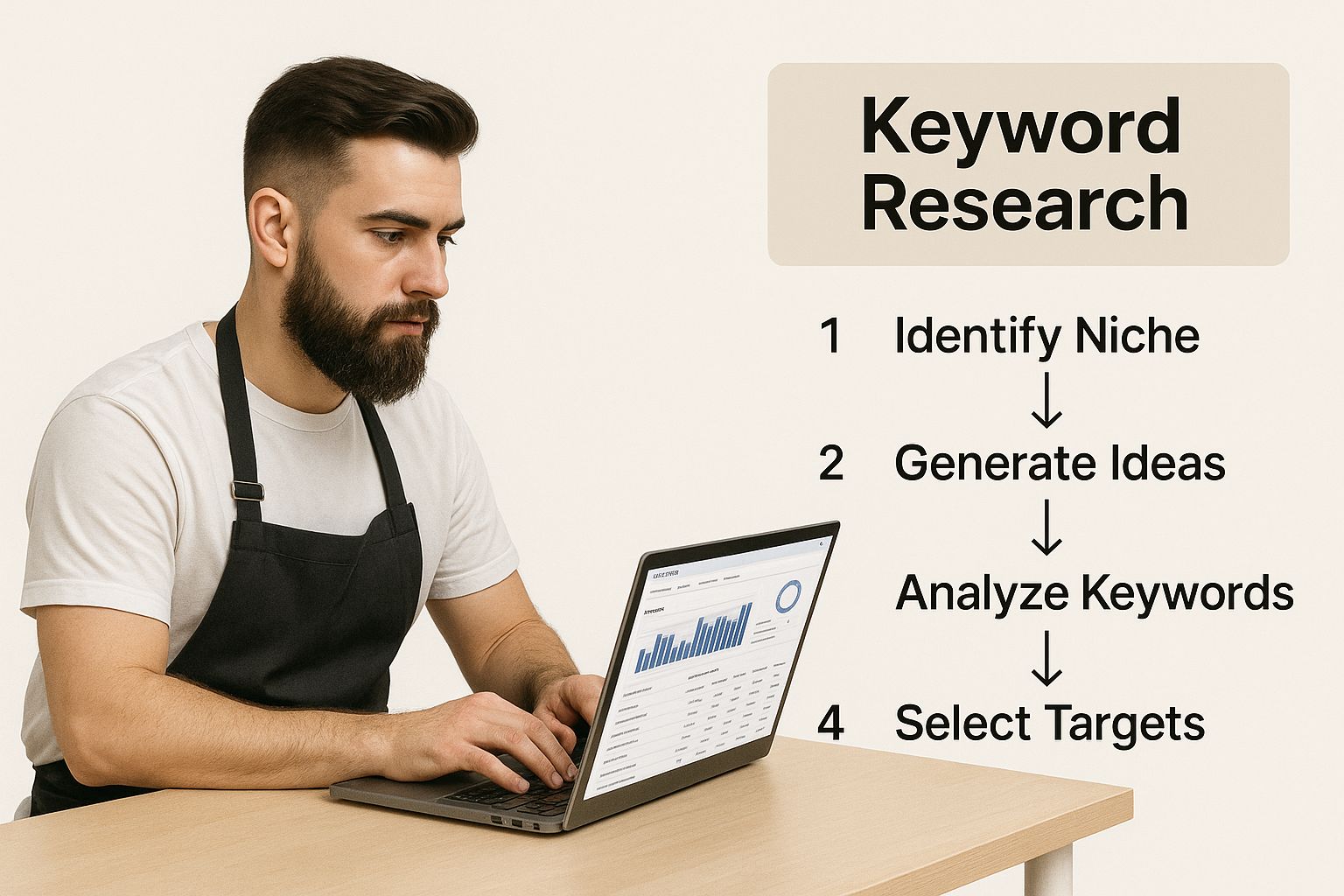
This shows that good SEO starts with understanding the exact words your clients use.
Supercharge Your Profile with All Features
A basic profile is okay, but a complete one gets you bookings. Use all the tools Google provides.
- Photos and Videos: Constantly upload high-quality photos. Show off your best cuts, the shop's vibe, your team, and happy clients. Pro tip: Geotag your photos before uploading to add another powerful local signal.
- Google Posts: Think of this as a mini-blog for your shop. Announce openings, show off a fresh cut, or run a special. Try to add a new one weekly.
- Q&A Section: People will ask questions here. Answer them quickly. You can even ask and answer common questions yourself, like "Do you take walk-ins?" or "How much for a beard trim?"
- Booking Button: Make it simple to book. Connect your scheduling software directly to your GBP. This lets clients book without leaving the Google search page.
Combining a great Google Business Profile with broader local SEO strategies builds the trust and authority that bring more customers through your door.
Finding Keywords That Put Clients in Your Chair

"Keyword research" sounds technical, but it's just about understanding how your customers think. It's figuring out the exact phrases they type into Google when they need a haircut.
Are your clients searching for "men's grooming solutions" or "best fade near me"? It’s almost always the second one. Your job is to find those phrases that mean, "I need a haircut right now!" This is the foundation of good SEO for barbers.
Brainstorming Your "Money" Keywords
Let's identify your "money" keywords—the terms people use when they're ready to book. These usually mix a service with a location.
First, list every service you provide.
- Skin Fade
- Beard Trim
- Hot Towel Shave
- Taper Haircut
- Kids Haircut
- Buzz Cut
- Shape Up / Line Up
Now, connect those services to your location. Be specific. Think about your city and your specific neighborhood.
- Skin fade Williamsburg
- Best barber for beard trim in Brooklyn
- Hot towel shave near McCarren Park
These longer phrases are gold. Someone searching "hot towel shave near McCarren Park" isn't just browsing. While the basics are similar across local businesses, you can see how others adapt this in guides like this one for SEO for a cleaning business.
🔑 In Short: Your most powerful keywords follow a simple formula: [Your Service] + [Your Location]. This attracts clients who are ready to book.
Using Google Maps as a Keyword Tool
You already have a great free keyword tool: Google Maps. It’s designed to guess what people are searching for.
Open Google Maps and start typing one of your services, but don't hit "search." Pause and see what Google suggests. These are a direct look into what local searchers want.
For example, if you type "barber for," you’ll see what people near you are looking for.

This simple trick can uncover terms you hadn't considered, like "barber for long hair" or specific fade styles popular in your area. Add any relevant ones to your list.
Spying on Your Competition (The Smart Way)
Check out the websites of the top 3–5 barbershops that appear when you search for your main services.
Look at their homepage and service pages. What language are they using?
- Do they say "modern fades" or just "fades"?
- Do they promote "traditional barbering"?
- Which neighborhoods do they mention by name?
You're not copying them. You're gathering intel. If every top shop mentions "classic cuts," that's a clue that you should use that term, too. This process will give you a solid list of keywords for your website and Google Business Profile.
Build a Website That Google and Humans Love
You have your keywords. Now, it's time to use them on your website. Your site is your digital storefront—it needs to be sharp, easy to navigate, and clear about what you do and where you are.
Good on-page SEO isn't about stuffing keywords everywhere. It’s about creating a helpful experience for Google and for people. A confusing website is like a messy shop floor; people will leave.
Create Dedicated Pages for Your Core Services
A common mistake is putting all services on one generic page. This is a missed opportunity for SEO for barbers. To show up for a search like "beard shaping in Denver," you need a page specifically about that service.
Create individual pages for your most valuable offerings. For example:
- A page for Modern Fades
- A page for Classic Hot Towel Shaves
- A page for Beard Shaping & Care
- A page for Kids' Haircuts
Each page acts like a magnet for specific searches. It gives you space to use your target keywords naturally and signal to Google that you’re the local authority on that service.
Write Page Titles and Descriptions That Get Clicks
Your page title (title tag) and meta description are the first things people see in Google search results. This is your chance to get a click.
A simple formula for titles is: [Primary Keyword] | [Your Shop's Name] | [City, State]
- Example Title: Expert Beard Trims in Austin | Joe's Barbershop | Austin, TX
- Example Description: Looking for the best beard trim in Austin? Joe's Barbershop offers precise shaping, hot towel treatments, and expert grooming advice. Book your appointment today!
The description answers the searcher's question, offers a benefit, and includes a clear call to action.
Don’t Let a Bad Website Kill Your Vibe
User experience is a huge part of SEO. If your site is slow or hard to use on a phone, people will leave, and Google notices.
🔑 In Short: Mobile is everything. Most people searching for a local barber are on their phones. If your site isn’t mobile-friendly, you're losing customers.
A recent marketing study found that optimizing a website for mobile can lead to conversion rates up to 2.5 times higher. You can read more about these barbershop marketing findings to see how critical a mobile-first approach is.
Your site must have:
- A Clean, Simple Layout: Make it easy for visitors to find your services, prices, and location.
- Fast Loading Speed: Your site should load in under three seconds.
- A Big "Book Now" Button: Make it obvious how to book an appointment. This button should be on every page.
People Also Ask About Barber Websites
How do I make my barbershop website stand out?
Use real, high-quality photos of your actual work. Stock photos look cheap. Show off your shop's vibe, your team's personalities, and the great cuts you produce daily.
What should I put on my barbershop website?
Your homepage needs the essentials: location, hours, a "Book Now" button, and main services. You also need dedicated service pages, an "About Us" page, a gallery, and a contact page with a map.
How can I improve my website's local SEO?
Embed a Google Map of your location on your contact page. Also, make sure your shop's name, address, and phone number (NAP) are identical and in the footer of every page. This reinforces your location to search engines.
One more tip: optimize your image files. Before uploading a photo of a fade, rename the file from IMG_8475.jpg to modern-skin-fade-downtown-austin-barber.jpg. This gives Google extra context.
Turn Happy Clients into Your Best Marketing Tool
Your most powerful marketing tool is a happy client. Search engines trust what real customers say about you more than what you say about yourself.
When you get positive reviews and your shop's info is consistent online, you build trust. This trust convinces new clients and Google's algorithm that you're the real deal. This part of SEO for barbers is about turning real-world satisfaction into online proof that attracts new people.
How to Get More Google Reviews Without Being Annoying
Getting reviews is important, but nobody wants to be pushy. The secret is to make it easy and ask at the right moment.
When is that? Right after they see their new cut and are smiling. That's when their satisfaction is highest.
🔑 In Short: Most happy customers are willing to leave a review. They just forget. Your job is to give them a gentle reminder and a simple link.
Here’s a simple, two-step process:
- The Verbal Ask: As they're leaving, say something casual like, "Hey, if you love the cut, would you mind leaving a quick review on Google? It really helps us out."
- The Text Follow-Up: A few hours later, send a short text. People are more likely to click a link in a text than in an email.
Feel free to use this template. Just get your unique review link from your Google Business Profile first.
SMS Template:
Hey [Client's Name], it's [Your Name] from [Your Shop]. Great seeing you! If you have a second, a review on Google would mean a lot. Here’s the link: [Your Google Review Link]. Thanks!
This simple system can boost your review count without being annoying.
Why Your Shop's NAP Is a Big Deal
Let's talk citations. This is just a word for any place online that lists your shop's Name, Address, and Phone number (NAP). Think of sites like Yelp, Apple Maps, and local blogs.
Why does this matter? Because Google uses these listings to verify your business. When it finds your exact NAP details consistently across many reputable sites, it becomes more confident that you're a legitimate local business.
Consistency is everything. If your shop is "Joe's Barbers" on one site and "Joe's Barber Shop" on another, it's a red flag for Google. This confusion can hurt your local search rankings.
Where to Build Your Local Citations
You don't need to be listed everywhere. Focus on the sites that matter for local businesses.
Start with this list:
- Google Business Profile (Your #1 priority)
- Yelp
- Apple Maps
- Yellow Pages (YP.com)
- Bing Places
Go through each of these, claim your listing, and triple-check that your NAP is 100% identical everywhere. Is it "Street" or "St."? "Suite" or "Ste."? Pick one format and stick to it. This detail is what builds your shop's authority in local search.
Create Content That Showcases Your Craft

Let's talk about content. This is how you go from being just another barber to the go-to expert in your town. A simple blog is about proving your skill and building a reputation.
Good content turns your website from a business card into a magnet for new clients.
Think this is too much work? The Shave Cave, a barbershop in Florida, increased their organic website traffic by 2,275% in just three months. About 90% of that jump came from a single blog post about men's hairstyles. It's a powerful strategy, and you can read the full case study on this incredible growth to see what’s possible.
Brainstorming Content Clients Actually Want
The best ideas come from your shop. Listen to the questions you get asked every day. Those conversations are content gold.
People are always looking for answers to their grooming problems. Your blog is the perfect place to provide them, while showing off photos of your actual work.
Here are a few ideas:
- The Top 5 Men's Haircuts for Summer in [Your City]
- A Barber's Tips: How to Maintain Your Beard Between Trims
- The Best Hairstyles for Guys with Thinning Hair
- What’s the Difference Between a Taper and a Fade?
- My Guide to Picking the Right Hair Product
Each topic answers a real customer question and frames you as the expert.
🔑 In Short: Your blog becomes a living portfolio. When someone searches for "best haircuts for thinning hair," finds your post, and sees real photos of your clients, you've built massive trust.
How to Write a Blog Post That Ranks
You don't need to be a professional writer. You just need to be helpful.
Keep your posts focused on one topic. Use short paragraphs, bullet points, and lots of great photos of your work. If you need help, you can use tools that offer AI prompts for digital marketers, which you can adapt for your blog.
Remember to use your keywords naturally. If you're writing about beard care, make sure phrases like "beard trim tips" and "how to maintain a beard" appear in your headings and text. This simple plan helps you create content people want to read, turning your expertise into more appointments.
Quick Answers to Your SEO Questions
Let's get straight to it. Here are the simple answers to the most common questions barbers have about getting more clients from Google.
How long does SEO take to work for a barber?
You can see results fairly quickly. If you optimize your Google Business Profile, you could see a jump in local rankings in just a few weeks. This means people searching "barber near me" might find your shop much sooner.
However, ranking for competitive terms like "best fade in [Your City]" is a longer process. For those bigger wins, you're looking at 3-6 months of consistent effort.
🔑 In Short: You'll see quick wins from your Google Profile in a few weeks, but true dominance takes a few months of dedicated work.
Can I do my own barbershop SEO?
Yes, absolutely. You don't need a marketing degree to handle the most important parts of SEO for barbers. Some of the most effective tasks are things only you can do.
- Your Google Profile: You know your hours, services, and best photos.
- Customer Reviews: You're the best person to ask for a review after a great cut.
- Simple Content: Taking a photo of a fresh cut and writing a few lines about it is all it takes.
What is the most important part of SEO for a barber?
If you only focus on one thing, make it your Google Business Profile (GBP). This is the business listing with the map that shows up in local search results.
Think of it as your shop's digital front door. It’s often the first impression a potential client gets. It is, without a doubt, your single most powerful tool for getting new customers. While SEO is a great long-term strategy, some shops want results faster. For them, it's worth knowing why some prefer PPC over SEO for an instant traffic boost.
Ready to stop relying on walk-ins and start having new clients find you daily? Clicks Geek specializes in local SEO that fills appointment books. Talk to an expert today and let's get your shop to the top of the local search results.
Is Your Business Ranking in Google Maps?
Turn Google Maps into a Lead Engine w/ Clicks Geek’s AI-powered local SEO. 3,000+ clients served. Our proprietary, fully done-for-you Maps SEO system handles everything—keyword targeting, local optimization, content, reviews, and ranking strategy—automatically.


